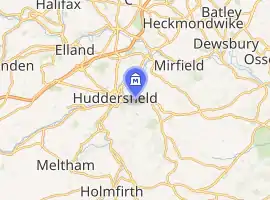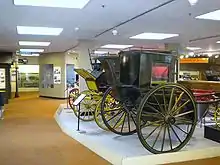Tolson Museum
The Tolson Museum is housed in Ravensknowle Hall, a Victorian mansion in Ravensknowle Park on Wakefield Road in Huddersfield, West Yorkshire, England. The museum was given to the town in memory of two brothers killed in World War I. Originally a natural history museum, it is run by Kirklees Council and has a wide range of exhibits related to the area's cultural and industrial history.
Tolson Museum | |
 Tolson Museum in Ravensknowle Park | |

| |
| Location | Huddersfield |
|---|---|
| Coordinates | 53.6449°N 1.7555°W |
| Website | Tolson Museum |
History
Ravensknowle Hall was built in the late-1850s for a local textile baron, John Beaumont. The house was designed by the London architect, Richard Tress who designed the mansion in a "palatial Italian style" and cost about £20,000. Beaumont died in 1889 leaving the house to his daughter who sold it to a relative, Legh Tolson.[1]
In 1919 Legh Tolson gave Ravensknowle Hall to Huddersfield Corporation to use as a museum in memory of his two nephews, brothers 2nd Lieutenant Robert Huntriss Tolson, killed on 1 July 1916 at the Battle of the Somme, and 2nd Lieutenant James Martin Tolson who died in the closing stages of World War I on 2 October 1918. The museum was formally opened on 27 May 1922.[2][3] Their sisters were the suffragettes Catherine Tolson and Helen Tolson.
Originally a natural history museum with an extensive collection of rocks and fossils[4] the Tolson Museum was revamped from the 1980s to feature the industrial history of the Huddersfield area, including the manufacturing of textiles and road vehicles.[5]
Exhibits

Exhibits of local archaeology, weaving machinery and textiles, and natural history with an extensive collection of stuffed birds occupy the museum galleries.[6] A reconstruction of a Victorian schoolroom allows children to experience the type of teaching used in that era.[7] A ground floor extension at the rear of the building houses a transport exhibition including roadbuilding techniques and horsedrawn and motor vehicles including Britain's rarest car – the three-wheeled LSD – which was manufactured in Huddersfield between 1919 and 1924. It was made by Sykes and Sugden Ltd from 1919 to 1923 and then by the LSD Motor Company in Mirfield from 1923 to 1924. Another local make of car, the Valveless, made by David Brown Ltd., is on display after being recovered from South Africa.[5]
The Grade II listed remains of a hypocaust, comprising the rubble columns and tiled floor from Slack Roman Fort were moved and reconstructed in Ravensknowle Park.[8]
See also
References
Notes
- Sheeran 1993, p. 123
- "History spotlight ... Dalton". The Huddersfield Daily Examiner. Retrieved 5 June 2010.
- "The soldiers". leeds-pals.com. Retrieved 5 June 2010.
- "Discovering UK Collections". Cornucopia. Retrieved 5 June 2010.
- George, David (2002). "The Transport Gallery at the Tolson Memorial Museum, Ravensknowle Hall, Huddersfield". Yorkshire Archaeological Society Industrial History Section. Retrieved 5 June 2010.
- Kellaway, Kate (22 November 2009). "To a birdwatcher, one glimpse, one moment is happiness enough". The Observer. Retrieved 5 June 2010.
- "Tolson Museum". UK School Museums Group. Retrieved 6 June 2010.
- Historic England. "The remains of Hypocaust from Slack Roman Camp re erected in Ravensknowle Park, Wakefield Road (1266976)". National Heritage List for England. Retrieved 22 August 2015.
Bibliography
- Sheeran, George (1993), Brass Castles, Ryburn, ISBN 1-85331-022-0